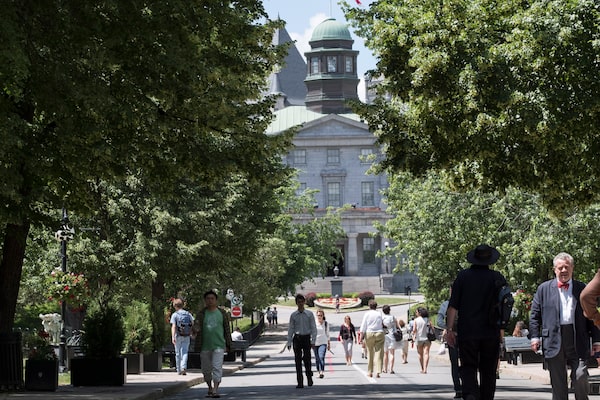
There are seven core expenses that should be considered when estimating the cost of a child’s postsecondary education: tuition and ancillary fees, books and supplies, accommodation, food, entertainment, transportation and personal-care costs.Paul Chiasson/The Canadian Press
When our son, Michael, was applying to universities last year he announced that he wanted to travel to Switzerland to attend the Lucerne University of Applied Sciences and Arts. My first thought was simply how much this was going to cost. When I researched the school, I noticed that it offered bachelor’s and master’s programs in yodelling. So, I then had dreams of my son travelling from coast to coast wearing lederhosen, performing for hundreds of people as North America’s premier yodeller – while I support him financially. He then reassured me that he wanted to study business.
As it turns out, my son stayed in Canada for his postsecondary education – which dramatically reduced the cost. If you’re a parent or grandparent who is thinking about the postsecondary education of a child in your life, you should think about two things: 1) what the cost will be, and 2) how you can help to pay for it. Let me share some thoughts today.
The costs
There are seven core expenses that should be considered when estimating the cost of a child’s postsecondary education: tuition and ancillary fees, books and supplies, accommodation, food, entertainment, transportation and personal-care costs. If you can estimate these over a four-year program, you can make huge headway in planning for these costs.
If you have a child starting postsecondary school today, a reasonable estimate for these costs might look like this for a student living away from home for eight months and enrolled in a typical bachelor’s program (some business or other programs could cost more): tuition and ancillary fees $7,000; books and supplies $700; accommodation $7,200 (could be more if living on campus; most leases are for 12 months); food $2,800; entertainment $1,200; transportation $1,200 (more if they have a car); and personal care $1,200. In this case, the total for four years could be $90,000.
Now, if we assume tuition inflation of 5 per cent annually, and inflation of 3 per cent for other costs, the four-year total for a student starting postsecondary school five years from now could be $107,900. If starting in 10 years, it could be $129,500; in 15 years, $155,900; and 18 years from now, $174,500.
The costs can be reduced, of course, if your student lives at home while going to school. If we remove accommodation and food costs from the figures above, a four-year program for a student starting this year would cost about $48,000; starting in 10 years, $73,300; in 15 years, $90,750; and starting 18 years from now, $103,200, assuming the same inflation rates.
The approaches
These are no small dollars. So, how can all of this be paid for? There are five ways. You’d be smart to plan well ahead of time which methods you’ll use. Here they are:
- Begging. This is the idea of your child applying for free money in the form or scholarships, bursaries, awards, grants or fellowships. Check out canada.ca and type “student grants” in the search field; universitystudy.ca (click on Plan Your Studies), or scholarshipscanada.ca. Ideally, the student should apply for these six to 12 months in advance of the school year.
- Borrowing. Debt to pay for an education is arguably a good type of debt if it’s not excessive. For every $10,000 of student debt, make sure the student, after graduation, can earn $10,000 over a base of $10,000 to ensure the debt can be repaid over 10 years. For example, if the student graduates with $30,000 of debt, they ought to earn $30,000 over a base of $10,000, or $40,000 annually to pay off that debt in 10 years.
- Stealing. This idea involves parents or grandparents “stealing” from other assets to help pay for an education. This could be making withdrawals from a registered retirement savings plan or a tax-free savings account, or selling other assets to cover education costs. Saving for your own retirement should take priority over paying for your child’s education given the other approaches available to pay for school.
- Sweating. The idea here is to have your child work to earn an income to help pay for school. Working full-time in the summer months, part-time during school (keep the work hours under 12 to 15 per week if enrolled full-time) or enrolling in a co-op program can really help to cover education costs. Students can check out jobbank.gc.ca for opportunities.
- Saving. Saving for a child’s education is important – but it does take a few years to accumulate a meaningful amount. Use a registered education savings plan (RESP) and receive Canada Education Savings Grants (CESGs) for contributions. CESGs are 20 per cent on the first $2,500 contributed to an RESP each year, or $500 ($100 higher in some low-income cases), with a lifetime maximum of $7,200 per student.
Tim Cestnick, FCPA, FCA, CPA(IL), CFP, TEP, is an author, and co-founder and CEO of Our Family Office Inc. He can be reached at tim@ourfamilyoffice.ca.